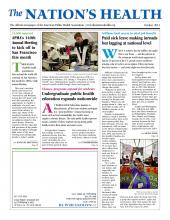When a waitress has the sniffles, she might like to stay home — and the patrons in the restaurant would surely appreciate it. But for 40 percent of the U.S. private sector workforce, missing a day of work is not an option. If they stay home, they lose income — and some might even lose their jobs.
Millions of Americans do not have access to even a single day of paid sick leave, but a movement is gaining traction in some states and municipalities to change that reality.
“Support for paid sick leave policy is huge,” said Leticia Mederos, vice president of the National Partnership for Women and Families. “When you ask people about it…they say ‘I need time to take care of children, parents or my own health.’”
Despite its popularity, efforts to create a national sick leave policy have so far been unsuccessful. Rep. Rosa DeLauro, D-Conn., has introduced a bill six times in the House of Representatives. Her most recent bill, H.R. 1876, also known as the Healthy Families Act, would require certain employers who employ 15 or more people to allow their employees to earn one hour of sick time for every 30 hours worked.
“It is in the best interests of our nation, and especially our families, to ensure American workers have access to paid sick days,” DeLauro said in a statement.
So far, DeLauro’s bills, several of which were also supported by the late Sen. Ted Kennedy, D-Mass., have not been brought up for a vote in Congress.
And so states and municipalities have forged ahead. San Francisco was among the first, passing a law in 2007 that allowed workers to accumulate an hour of paid leave for every 30 hours of paid work, to a maximum of nine days per year in larger firms and five days per year in smaller firms.
Seattle and Washington, D.C., followed suit. Bills have also been introduced in Philadelphia; Portland, Ore.; Miami; and Orange County, Fla. In 2011, Connecticut became the first state to pass a paid sick leave requirement, and legislation has been introduced in more than a dozen other states.

Protesters from Make the Road New York, a group that supports workers’ rights and social justice, show their support for paid sick leave legislation that was before the New York City Council in 2009.
Photo by Corey Sipkin, courtesy New York Daily News/Getty Images
The Seattle ordinance, which was passed in 2011, became effective Sept. 1. It was sponsored by City Councilmember Nick Licata, who said he felt the requirement was important because, “quite literally, it will make Seattle a happier, healthier city.”
“I think it makes Seattle a more attractive place to both live and to do business,” he told The Nation’s Health.
Success in Seattle was the result of coalition building, Licata said. Through outreach, those who supported the law were able to build a coalition of small business owners who proved integral to the ordinance’s success.
“They played a critical role,” he said. “They helped create a public message that this was not an anti-business (measure). In working with and talking to small businesses, we were able to address their concerns and bring them into a coalition.”
In New York City, a bill that would require paid sick leave has the support of a majority of voters, according to recent polls, but concerns about its effect on business have reportedly kept the City Council from voting on it.
Licata said Seattle benefitted from San Francisco’s willingness to act as a test case for paid sick leave programs. A study of the San Francisco program, released in February 2011 by the Institute for Women’s Policy Research, found that employer profitability did not suffer. Two-thirds of employers surveyed for the study approved of the ordinance and one-third were “very supportive.”
The study also found that black, Hispanic and low-wage workers were the primary beneficiaries of the law.
Other studies have shown that giving workers paid sick leave to recover from illness or care for a sick family member can actually benefit their employers.
According to the National Partnership for Women and Families, allowing a worker to take paid sick leave, rather than terminating the worker, can save employers from the need to replace the worker, which can cost anywhere from 25 percent to 200 percent of annual compensation. It also helps reduce losses from presenteeism — working less productively because one is ill — which is estimated to cost $160 billion nationally every year.
Beyond benefitting employers, paid sick leave may also have public health benefits. One study, conducted by the Centers for Disease Control and Prevention and published in the September issue of APHA’s American Journal of Public Health found that workers with access to paid sick leave are 28 percent less likely to suffer a work-related injury.
Sick workers who feel pressure to go to work for financial reasons may be more likely to be injured for a number of reasons, said Abay Asfaw, PhD, the study’s lead author and a researcher in CDC’s National Institute for Occupational Safety and Health.
“Workers may take medication that causes drowsiness,” he told The Nation’s Health. “They may be fatigued and their ability to concentrate may be impaired. They might find it hard to follow directions. All of these things can lead to injury.”
For the AJPH study, researchers looked at data from 2005–2008 involving 38,000 private sector workers. Health care practitioners and technicians without access to paid leave were 18 percent more likely to be injured than their counterparts with paid leave.
Construction workers were also at high risk. Those without access to paid leave were 21 percent more likely to suffer an injury than those with leave.

Megan Sacks of Tacoma, Wash., shown in 2010, learned first-hand the importance of paid sick leave policies. As a waitress without paid sick leave, she worked while sick. A customer called the health department and she was fired. She later met with legislators in Congress to advocate for paid sick leave.
Photo by Dean Koepfler/Tacoma News Tribune/MCT/Getty Images
“What we are trying to do in this study is to show employers that providing paid sick leave to workers can be a win-win solution for both the workers and the employers,” Asfaw said.
Asfaw also noted that previous studies have shown that paid sick leave is associated with shorter recovery times and may help prevent the spread of communicable disease. The next step is to investigate a cost-benefit analysis of paid sick leave, he said.
John Howard, MD, director of CDC’s National Institute for Occupational Safety and Health, said the study highlights how work lives and personal health are intertwined.
“The concept of total worker health, which involves creating an environment of well-being both at home and at work, is an important aspect of the American economy as we depend on able and productive workers,” he said in a news release discussing the study.
While paid sick leave may be gaining traction and popularity, the trend is not completely positive, said Andy Baker-White, JD, MPH, of the Network for Public Health Law-Mid States Region at the University of Michigan School of Public Health.
Laws passed recently have tended to give employers more leeway. Seattle’s law does not include all employers, just those with a certain number of workers, and newer employers have a few years before they are required to comply, he said.
Likewise, in Connecticut the law allows individual municipalities to create stronger paid sick leave program requirements than those in the overarching state law. But other states, such as Wisconsin, have specifically preempted cities and municipalities from passing such ordinances.
“It worries me a bit,” Baker-White told The Nation’s Health.
Mederos said that action at the national level seems unlikely in the near future.
“I think while we see this huge polarization in the Congress…we have to have movement at the state level,” she said. “It’s not ideal. We need a national standard, but since we are where we are in terms of congressional activity, where the conversation is nowhere, we have to look to the states.”
For more information, visit www.paidsickdays.org.
Editor’s note: This article was corrected post-publication
- Copyright The Nation’s Health, American Public Health Association









